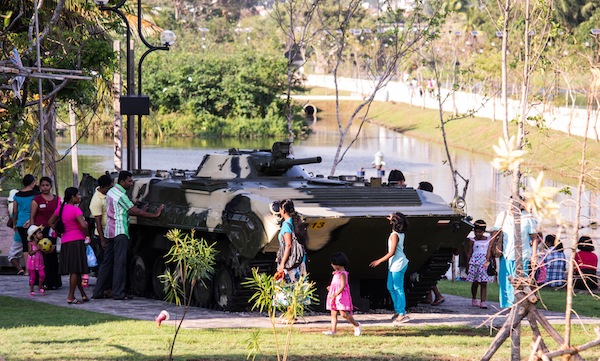“As an abstract political force, poverty is very useful; it scares and disciplines the working classes, keeps wages down…” Parenti, 1999
Visible urban poverty disrupts the gilded cityscape. It shatters the sanctity of the urban metropolis and perhaps, most importantly, it isn’t good for business.
The beautification of urban spaces has been central to a new program of neoliberalisation for postwar state building. Championed by the Rajapaksa administration, the urban renewal of Colombo serves as a crutch for political support and consolidates a cosmopolitan playground for high commerce, high technology and tourist industries. Major infrastructure projects, including the construction of highways, harbors and international hotel chains, have been pursued to transform and rebuild the post war state.
Urban aestheticism masks scars of political turmoil, securing a metropolis for neoliberal accumulation.
Following the end of the civil war, weak governing institutions and gutted state infrastructure produced a vacuum for civil administration. Bolstered by pro-military narratives, the military was forwarded as an institution that could effectively translate military discipline into governance and public administration in the post war era. A job vacuum for approximately 300,000 military personnel, many of whom only knew a career in combative exercise and wartime tasks, necessitated a new function for military personnel. The mandate of the military has since expanded to include police duties and state building exercises, specifically through the administration of urban development.
While Omicron rages and Sri Lanka endures its worst economic crisis since independence, Colombo revelled in the city’s ostensible beauty this holiday season. In a stunning display of lights and decor, the Akuregoda new army camp road attracted hundreds of spectators to participate in Christmas festivities. While festivities were welcomed after a bleak year, the rebranding of the military as an administrator of urban beautification reveals an encroachment of the state’s coercive institutions in public life and the sinister underbelly of urban development.
The contradiction of urban restructuring lies in the polarization of poverty and development. Programs of rapid neoliberalisation have plunged Sri Lanka into a massive borrowing crisis with over $30 billion in debt to market borrowings, the Asian Development Bank and the World Bank. Reliance on imports, outsourcing and foreign direct investment leaves behind a barren economic landscape and a saturated job market. Urban development projects conceal mammoth corruption schemes designed to provide monetary cuts to political elites.
It is logical, then, that the evolution of urban policing reflects the demands of neoliberalism. Policies of deregulation, privatization and gutted social services impel mass poverty and unemployment, creating ‘surplus populations’ rendered obsolete to high commerce demands.
The crisis of neoliberalisation becomes the management and containment of surplus populations and it is fulfilled through zero tolerance and quality of life policing under a grossly expanded military mandate.
In a nouveau manifestation of the 1834 Poor Law, Zero Tolerance (ZT) and Quality of Life (QOL) policing refers to draconian law enforcement against minor offenses that reduce the quality of life in urban spaces. Initially championed by former New York Police Department commissioner William Bratton and then extended across newly gentrified cities, ZT and QOL strategies are based on the Broken Windows Theory that stipulates that if police address the small quality of life offenses that create disorder, then violent crime will diminish. This includes nonviolent offenses such as homelessness, graffiti, unreasonable noise, loitering and panhandling.
The policing of QOL offenses is essential for securing city spaces for urban renewal. Zero tolerance policing secures cities as cultural sites of accumulation wherein visible urban poverty is a threat to a beautified, gilded cityscape and are thus targeted by militarized raids, arrests and evictions. To make urban spaces attractive to investment, minor quality of life offenses have been met with militarized force. Consider, for example, crackdowns on vague drug threats (generally referring to minor possession of cannabis, which constitutes the highest number of drug related arrests in Sri Lanka), through the establishment of the military-led Presidential Task Force to Build a Secure Country, Disciplined, Virtuous and Lawful Society in June 2020. Urban policing renders poverty and social inequality a crime.
Beneath Colombo’s gilded cityscape lies a blueprint for increased military control. Military oversight of the Urban Development Authority (UDA) has authorized joint militarized policing campaigns to evict residents from prime real estate in order to boost a new high commerce, high technology post war economy and encourage foreign investment in Sri Lanka. Mass eviction schemes target many of the shanty towns within Colombo that are to be cleared for new high rise hotels, apartments and offices, perhaps best exemplified by developments in Slave Island where police and military have conducted multiple overnight raids and forced families to leave at 24 hours’ notice. From Castle Street to Mayura Place and Thotalanga Junction, a fortified military presence has been integral to the elimination of historic communities and dampening the potential for mass urban resistance.
The ethno-spatial character of Colombo gentrification is impossible to ignore. Concentrated in low income, predominantly Tamil and Muslim neighborhoods, the policing of urban development reflects ethnic fault lines of the war. The blow feels especially strong in light of the state’s allotment of 9.68 perches to popular singer Yohani de Silva, credited for boosting Sri Lanka’s international fame while the laborers and historic communities that literally built Colombo are rendered invisible.
The self-perpetuating cycle of neoliberal impoverishment produces a dilemma of surplus populations, pushed out of the city and contained in the urban periphery. The military consolidates as a formidable vessel for suppressing resistance through urban policing, mimicking a wartime mandate of oppressing, surveillance and displacing minorities.
As we observe Colombo’s beautification, it is crucial to ask whether we are securing a cosmopolitan playground or a battlefield.
